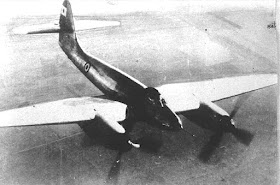rare, ugly, funny, strange, amazing and beautiful aviation things
Pages
▼
Saturday, 16 April 2011
I.Ae. 30 Ñancú
The I.Ae. 30 "Ñancú" was an Argentine twin piston engined fighter designed by the Instituto Aerotécnico (AeroTechnical Institute) in the late 1940s, similar to the de Havilland Hornet ,but made of metal rather than wood. Only one prototype was completed; the project was abandoned in favour of a jet aircraft.
Named after an indigenous eagle of Patagonia, and was designed by Italian engineer Cesare Pallavecino, who had come to Argentina in 1946. Pallavecino led a team of Argentine technicians and engineers in developing the concept of a high-speed escort fighter, intended to be operated in conjunction with the Avro Lincoln bombers used in the Argentine Air Force.
The I.Ae. 30 had a metal structure, its powerplants consisted of two Rolls-Royce Merlin 604 engines, each developing 1,800 hp at 3,000 RPM, and four-bladed propellers. The armament would consist of six 20 mm Oerlikon automatic cannons mounted in the nose, although later plans called for 20 mm Hispano-Suiza cannons as well as a 250 kg bomb under the fuselage and two batteries of five 83 mm rockets fitted underneath the wings. Nevertheless, the prototypes were unarmed.
By the end of 1947, a contract was received for the first of three projected prototypes. On 9 June 1948 the first prototype was ready for ground tests and on 17 July 1948, the I.Ae. 30 took to the air for the first time, piloted by Captain Edmundo Osvaldo Weiss
The test results proved that the aircraft possessed good flying characteristics as well as meeting performance specifications. During a cross country flight, from Córdoba to Buenos Aires, the Ñancú reached a level speed of 780 km/h, setting a new piston engined speed record in South America, an achievement that has not been surpassed. Although the prototype was achieving design goals, the Fuerza Aérea Argentina was already considering the jet I.Ae. 27 Pulqui I as their future fighter program.
With official interest diminishing, in early 1949, the sole flying prototype was badly damaged in a landing accident when test pilot Carlos Fermín Bergaglio misjudged a landing and crashed. Although the pilot was uninjured and the aircraft could have been repaired, the Fabrica Militar de Aviones made a decision to abandon the project with the wrecked prototype, as well as the two unfinished prototypes still at the factory, being scrapped.
Wikipedia
http://translate.google.com/translate?hl=en&sl=es&u=http://es.wikipedia.org/wiki/I.Ae._30_%25C3%2591anc%25C3%25BA&sa=X&oi=translate&resnum=3&ct=result&prev=/search%3Fq%3DI.Ae.%2B30%2B%2522%25C3%2591anc%25C3%25BA%2522%26hl%3Den%26sa%3DG%26ie%3DUTF-8




No comments:
Post a Comment